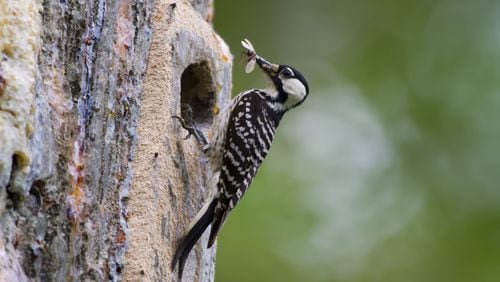The longleaf pine forest, one of the South’s most endangered ecosystems, is the preferred habitat of the little red-cockaded woodpecker, which is on the federal Endangered Species List. “The red-cockaded woodpecker is emblematic of longleaf forests,” noted Nathan Klaus, a senior wildlife biologist with Georgia’s Department of Natural Resources.
Georgia, however, has lost some 97% of its longleaf pine forest during the past 150 years, mostly due to logging and replacement with huge plantations of other pine species. With the loss of longleaf, red-cockaded numbers nose-dived and the bird faced extinction.
Now, thanks to Klaus, the DNR and several other groups, both the woodpecker and the forest are returning to an area of Georgia where they had been missing for decades. Here’s the story:
Some 20 years ago, the DNR undertook an intensive project to restore longleaf pine forests to thousands of acres at the Sprewell Bluff Wildlife Management Area in west central Georgia near Thomaston. A goal was to make the 6,500-acre refuge suitable habitat once again for the woodpecker and other wildlife. The small black-and-white bird hadn’t been seen there for nearly 50 years — due mostly to loss of the longleaf forest.
Last year, biologists deemed it was time to bring back the woodpeckers. In December, they captured three pairs of the endangered birds in a sprawling pine forest on the Fort Stewart Army base in South Georgia. That forest has a healthy red-cockaded population.
The birds were taken to their new home at Sprewell Bluff and released in an area where artificial nesting cavities had been installed for them in some older pines.
The biologists now hope that the introduced birds will be the seeds for a new red-cockaded population at Sprewell Bluff to increase the species’ numbers. Indeed, the birds obviously have taken a liking to their new home: This month, biologists were jubilant to find that two of the woodpecker pairs had produced babies.
That has made the biologists confident that a longleaf pine forest will again flourish at Sprewell Bluff, full of red-cockaded woodpeckers and other wildlife.
IN THE SKY: From David Dundee, Tellus Science Museum astronomer: The moon will be last quarter on Friday. Mars, Jupiter and Mercury are in the east just before dawn. Saturn rises in the east about three hours before dawn.
Charles Seabrook can be reached at [email protected].






